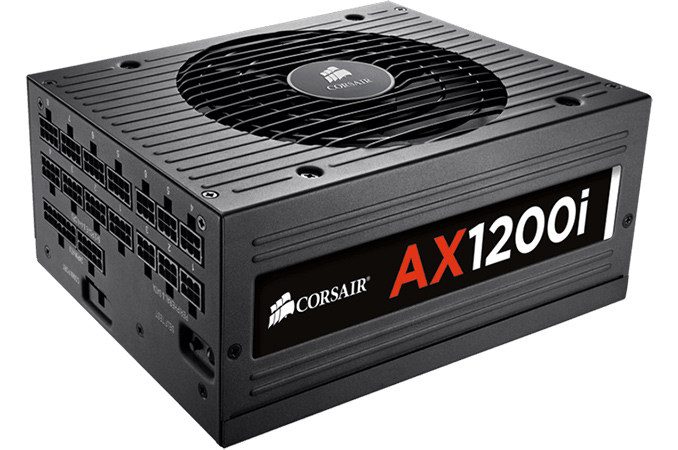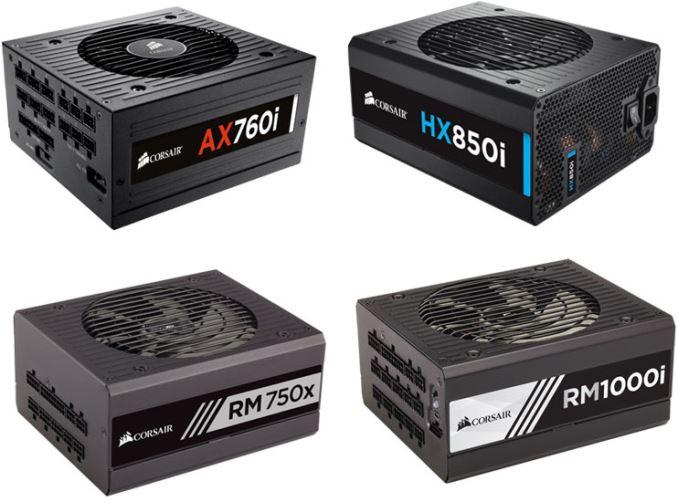Corsair Extends Warranty of Advanced PSUs to 10 Years
by Anton Shilov on April 15, 2016 12:00 PM EST- Posted in
- Cases/Cooling/PSUs
- Corsair
- RM Series
- HXi Series
- AXi Series

Unlike CPUs, video cards, motherboards and memory, power supplies do not get outdated after two or three years, which is why high-end PSUs usually survive multiple configurations. However, only a few companies offer warranty on advanced PSUs which are longer than five years. This month, Corsair became the second supplier to extend its warranty on its high-end PSUs to 10 years.
Effective immediately and retroactively, Corsair has increased the warranty of all AXi range (launched in 2012), HXi range (launched in 2014) and RMi/RMx range (launched in 2015) PSUs from 7 years to 10 years. The extended warranty covers not only newly purchased power supplies, but also all the PSUs that belong to the aforementioned families sold to date.
Note that Corsair did not extend warranties on its regular AX, HX and RM/RX PSUs, which were on the market for a long time, but now are not available from the company. While those power supplies are considered as good, Corsair upgraded capacitors, fans, heatsinks and some other internal components in their new PSU lineups (see our review of the RM1000i and the RM1000x PSUs for details), not to mention changed OEMs in some cases.
Most of power supplies on the market today are covered by 3 or 5 year warranties, but Antec, Seasonic and Thermaltake offer 7 year warranties on high-end PSUs. To date, only EVGA has covered its select PSUs with a 10 year warranty. As it appears, Corsair’s AXi, HXi, RMi and RMx power supplies are so good that Corsair wants to extend their warranties in a bid to show that.
Owners of Corsair’s power supplies do not need to register or contact the manufacturer anyhow to get the extra warranty coverage.
Source: Corsair (via The Tech Report)











19 Comments
View All Comments
Bob Todd - Friday, April 15, 2016 - link
Nods approvingly at unboxed RM1000i sitting next to my home server...DanNeely - Friday, April 15, 2016 - link
At least for higher end systems, doesn't the collection of power connectors end up being the limit? I've got a few PSUs that are in storage and semi-retired because they only have a 4Pin CPU plug or due to no/minimal numbers of 6 pin PCIe connectors. With some high end mobos now requiring a 4pin CPU connector as well as the 8pin one, and/or a PCIe connector to the mobo (in the expansion slot area, presumably to power multiple GPUs), and the on-going transition t 1x8 PCIe connectors instead of 2x6 on 150-225W GPUs; I'm concerned that some of my older current PSUs might be on their last box unless I use them for something far below their maximum rated or optimal efficiency loads.just4U - Saturday, April 16, 2016 - link
Well.. most buying PSUs even today would be hooped for that extra 4pin.. It's not standard with most power supplies and .. well.. lol.. if you see that hoaky thing evga did for some of their units it might work for longevity but not to many people were impressed by it. (4 pin connector attached to the 8 pin..)If their always looking to lower power consumption though ... it's not going to be all that normal for mainstream mbs to have connectors to the areas your talking about. More of a boutique thing no?
DanNeely - Sunday, April 17, 2016 - link
Some yes some no.The 2x6pin to 1x8 pin transition on GPUs will affect everyone.
8+4 CPU power may or may not go anywhere (for a some years 8pin was only seen on server/ultra high end parts). AFAIK it trickled down to mainstream parts due to a combination of more wires = less voltage drop and feature checkboxitits once it dropped from ultra-highend to high-enthusiast boards. 8+4 could end up doing the same thing at some arbitrary point in the future. Especially if 12V USB power takes off in the next few years. Adoption of the 20V charging standard could do the same, since it'd probably be made onboard via 12-20V DC converters. (Probably dreaming; but if it takes off I'd really like to see it as an excuse to design a new big ATX plug that has a bit more 12/20V and drops most of the nearly unused 3,3/5v wires.)
The extra connector in the GPU area probably won't ever go mainstream; but VR could result in 2 GPU setups being significantly more common and push it down to sli/xfire boards as a case of feature checkboxitits again.
just4U - Friday, April 15, 2016 - link
Well, they got to up their game somehow.. if they want to compete against the units coming out of Superflower and Seasonic.NZLion - Monday, April 18, 2016 - link
Annoying that it doesn't cover the SF range, I just ordered a SF600 a few days agokmi187 - Tuesday, April 19, 2016 - link
Well my first Corsair PSU was one of the first HX-520's to hit the stores. It's just over 10 years old now. Still keeps my q6600 running at 3.8 running 24/7 and going very strong.I'm usually not very brand loyal ... but when it comes to PSU's I refuse to settle for anything less than a corsair. HX or AX series preferably.
Aslan7 - Saturday, April 23, 2016 - link
I don't get why people treat their PSU's as so precious and incapable. It doesn't matter what connectors the PSU ships with only if it can supply the correct voltage at the correct amperage. For all the new connectors everything needs there's converters. So long as you stay below the capacity of the rail the converters are plugged into, you can have any number of spliters and converters. I had two power supplies from the 90's that I was running until recently. One did about 2 years extra duty recently of 24/7 usage and the other did 4 years of 24/7 duty before they each failed. I've since replaced them with 80+ platinum supplies, but it was nice to get a few extra years out of them.DanNeely - Sunday, April 24, 2016 - link
Unless you were running those 90s PSUs on p3/amdXP or earlier systems whatever they were powering was almost certainly being tortured by out of spec voltages and you're lucky you didn't smoke something as a result.Up until the last 5ish years virtually all PSUs used a design where the relative 3.3/5v vs 12v load needed to be in spec with what the PSU was originally designed for to keep voltages correct; a cross load situation would result in one pair going out of spec low and the other out of spec high. If you PSU was designed for a 50/50 load and you put a 90/10 load on it would be working very poorly even if you didn't go over the rated limit for the 12v rail. (Over the last few years the trend has been to replace that design with a pure 12v AC-DC unit and to then use DC-DC converters to power the 3.3/5v rails; you can ID this design via a specsheet where the max 12v output is within a few watts of the total PSU output.) Prior to the p4 the bulk of the stuff on the mobo was powered via 3.3/5v rails with only a little bit of 12v needed; and PSU designs were optimized as primarily 3.3/5v sources. The p4 was the first 12v centric CPU; and represented a breaking change as far as suitable PSU use.
The last comment I'll make is that the efficiency of those 20 year old PSUs was so awful that even in a low power system you almost certainly wasted several times the power consumption of a basic 80+ PSU by not replacing them years ago. In a cross load situation, your ancient PSU was probably only about 60% efficient (vs 70% if properly loaded). At that point for 100W of output power it needs 166W in, vs 125W for one running at 80%. One year of uptime at that load at a price of 10c/kwh would cost an extra $41 of electricity. Which's about the cost of a cheap 350w 80+ PSU.